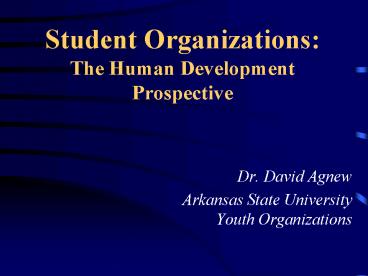Student Organizations: The Human Development Prospective - PowerPoint PPT Presentation
1 / 13
Title:
Student Organizations: The Human Development Prospective
Description:
The Human Development Prospective Dr. David Agnew Arkansas State University Youth Organizations – PowerPoint PPT presentation
Number of Views:81
Avg rating:3.0/5.0
Title: Student Organizations: The Human Development Prospective
1
Student Organizations The Human Development
Prospective
- Dr. David Agnew
- Arkansas State UniversityYouth Organizations
2
Your Involvement in Youth Organizations
- What organizations did you belong to when you
were in school? - What did it do for you? Why did you join?
3
Former PresidentFranklin D. Rossevelt
"We cannot always build thefuture for our
youth, but we canbuild our youth for the
future.
Franklin D. Roosevelt
4
Objectives, 1-3
- 1. Explain what is meant by Human Development.
- List the six stages of development as stated by
Havinghurst and using his model describe the
unique changes that Adolescence go through. - Describe the developmental characteristics of
youth age 14-19, and the implications for
education. - Source Needs of Youth --Extension Publication
(Texas)
5
Objective 1 Human Development?
- Human development is the physical and mental
process of growing from a one-celled zygote to an
adult human being. - Source http//www.answers.com/human20development
.htm - Developmental psychology is the scientific study
of age related changes in behavior across the
life span. This field examines change across a
broad range of topics including motor skills,
problem solving abilities, conceptual
understanding, acquisition of language, moral
understanding, and identity formation. - Source http//encyclopedia.laborlawtalk.com/Huma
n_development.htm
6
Objective 1 Human Development, Cont.
- Developmental Psychology---The branch of
psychology concerned with the study of
progressive behavioral changes in an individual
from birth until death. - Source http//www.answers.com/topic/developmental
-psychology.htm
7
Objective 1 Areas of Development
- Physical
- Social
- Emotional
- Psychological
- Gender differences
8
Objective 2 Stages of Human Development, by
Havinghurst
- 1. Infancy and Early Childhood (0-6)
- Middle Childhood (6-12)
- Adolescence (physical, social, and emotional
maturing is primary) (12-18) - Early adulthood (Marriage, pregnancy, first
serious full-time job, first illness of children,
making a home, etc.) (18-30) - 5. Middle Age (30-60)
- 6. Later Maturity (60)
9
Objective 2 Stages of Human Development,
Ericksons Model
- Infant Basic trust vs. basic distrust
- Toddler Autonomy vs. shame and doubt
- 3. Preschooler/Early Childhood
- Initiative
vs. guilt - 4. School Age/Play Industry vs. inferiority
- 5. Adolescence Identity vs. role
confusion - 6. Young Adulthood Intimacy vs. isolation
- 7. Adulthood Generativity vs.
stagnation - 8. Old Age Ego integrity vs.
despair
10
Objective 3 Characteristics of Adolescence,
Havinghurst
- Achieving new and more mature relationships with
age-mates of both sexes. - Physical changes take place
- Achieving a masculine or feminine social role.
- Developing fundamental skills in reading, writing
and calculating. - Able to deal with abstract concepts.
- Developing concepts necessary for everyday living
- Developing conscience, morality, and a scale of
values - Achieving personal independence (from
parental/teacher dependence to dependence on
self). - The formal operational stage is characterized by
the ability to formulate hypotheses and
systematically test them to arrive at an answer
to a problem.
11
Objective 3 Adolescence Implications for
Education
- 1. Provide for teaching social skills on as high
an aesthetic level as is practical, e.g.,
teaching, as informal as possible, party behavior
entering, planning parties, etc. - 2. Provide for satisfying social contacts.
- 3. Teach democratic political procedures the
child's experiences in the peer group - 4. We can present moral problems and dilemmas to
students and help them reach a satisfactory
answer - 5. Educators need to provide concrete
experiences, which are essential to good concept
development at this stage.
12
Objective 3 Adolescence Implications for
Education, Cont.
- Problem solving approach becomes easier for
students to understand and therefore easier to
teach content using this approach. - Project methods also work better for this age
than in lower grades - Group or team learning methods or projects become
important as a way to not only learn content but
to learn social skills. - Independence is aided by success experiences with
the peer group. The peer group and educational
activities serve as laboratories for developing
this task. We should involve youth in decision
making and planning - with adequate supervision.
conservation, anti-pollution work, child care in
day care centers, service in community health
centers, community music and dramatic activities.
13
In Review
- What is human development?
- What are the six stages of human development
according to Havinghurst? - What kinds of activities do Adolescences need to
be involved in? - Explain how a youth organizations can meet the
needs of Adolescences.






























